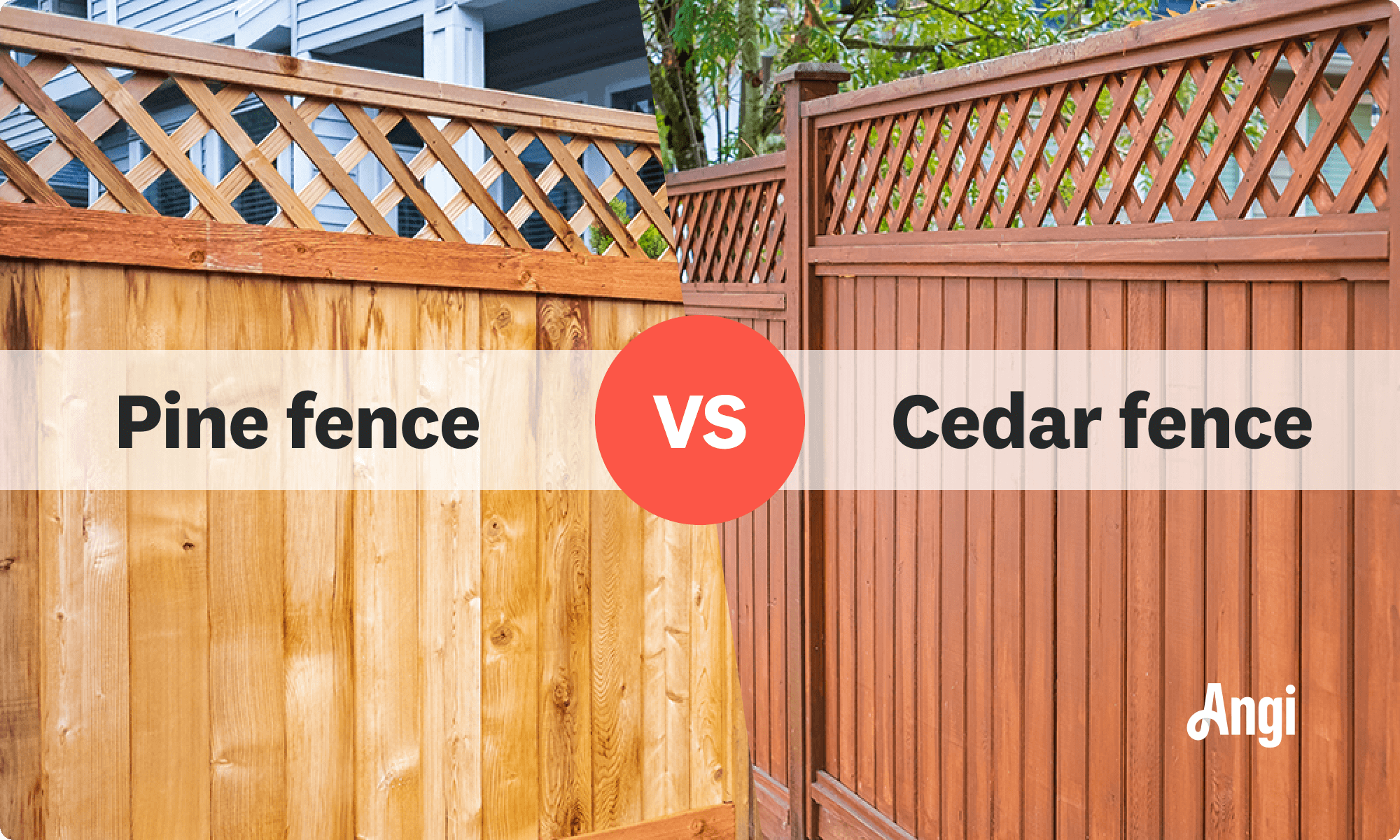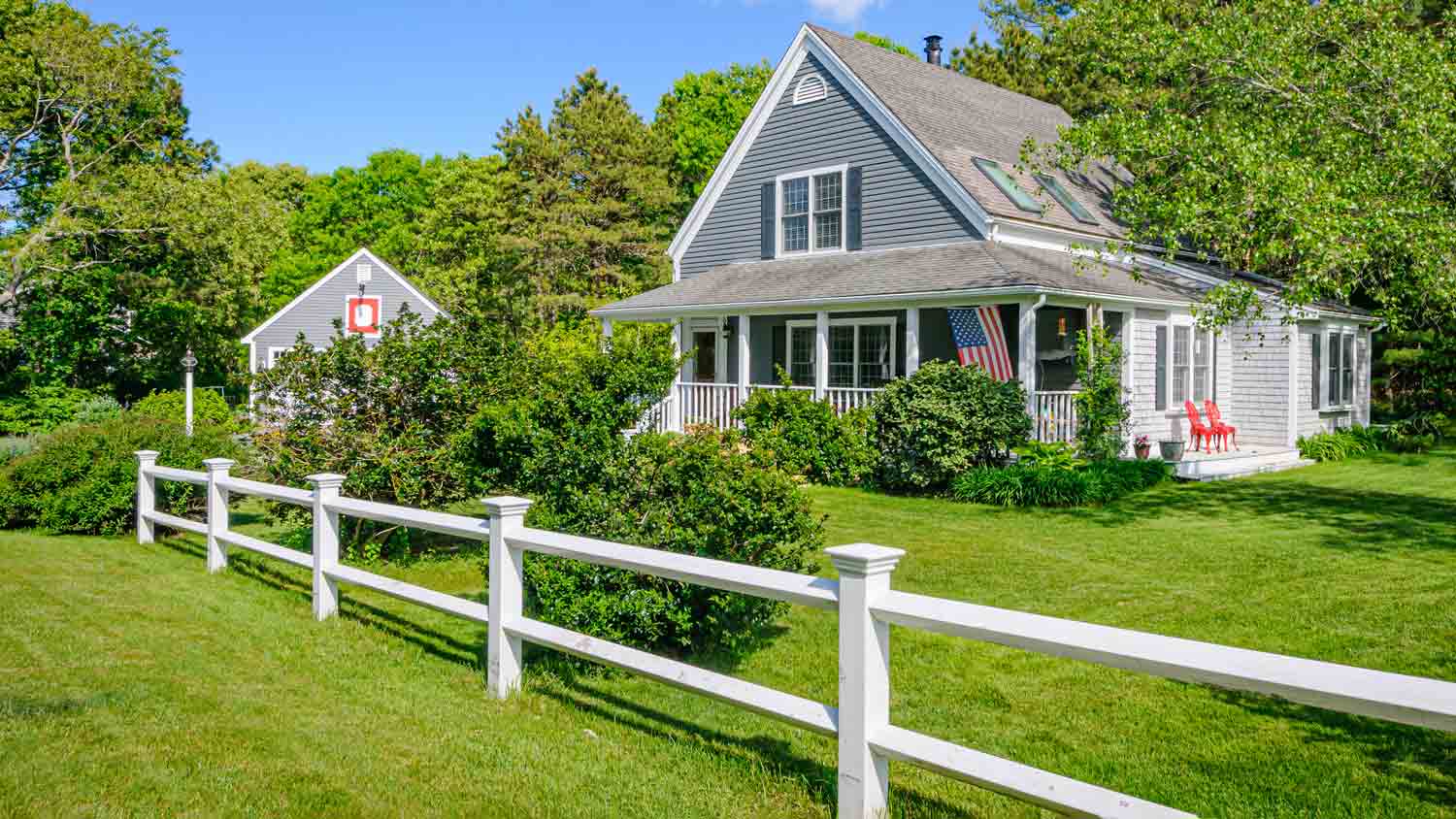
Pool fence costs depend on the type of fencing and the size of your pool. This guide will help you figure out the true cost of pool fence installation.
Find out whether luxurious cedar or budget-friendly pine is best for your fence


Cedar has natural weather- and insect-resistant qualities.
Pine costs less than cedar but requires more maintenance.
Cedar is expensive but lasts longer.
Cedar will rot quickly when buried in soil.
Pressure-treated pine is one of the most popular materials for wood fencing due to its affordability and availability, but it doesn’t quite match up to some other wood types in terms of visual appeal. Cedar offers natural beauty, eco-friendliness, and impressive durability due to its humidity-resistant oils, but it also comes with a steep price tag. Cedar is also considered environmentally friendly, as it doesn’t require chemical treatments.
If you’re ready to build a fence on your property, deciding between a cedar vs. pine fence can be a bit tricky. We’ll help you pick sides in this epic pine vs. cedar fence match-up so you can make the best decision for your project.
Choosing which type of wood to use in your fencing project can be difficult due to factors such as climate, aesthetics, and budget. Consider contacting a pro for advice on which is best for your home.
The key differences between cedar and pine are their prices, durability, and longevity. There are also noticeable differences in their appearance. Cedar is more expensive than pine, but is more durable and lasts longer. Pine is less expensive but more prone to damage and decay. Cedar has a red look, whereas pine has a pale yellow color.

Cedar’s natural resistance to decay and pests, as well as its rich red look, make it an ideal material for fencing and, for many, worth the comparably higher cost that comes with it.
| Cedar Pros | Cedar Cons |
|---|---|
| Beautiful red color | Expensive |
| Resist damage | Difficult to find |
| Low-maintenance | Posts rot in soil |
Best for:
Big-budget projects
A rich, sophisticated look
Regions with wet weather
Cedar is one of the best woods for fences because it naturally resists damage from moisture and insects, and also resists shrinking, twisting, and warping in the face of changing temperatures and humidity. Cedar requires less maintenance than other wood fencing materials. Cedar has an attractive rich brownish-red appearance with a tight grain pattern and few knots—so it’s beautiful, too. To top it off, cedar is also a sustainable natural resource.
One of the biggest drawbacks of cedar fences is their price. Cedar costs up to $5 more per linear foot than pine fencing. It also requires sealing every few years to prevent it from turning a gray color. Although it’s tough in wet weather, it does tend to rot when embedded in soil. If you do need to replace sections of your cedar fence, it’ll be hard to find the material in your local home improvement stores.

Pressure-treated pine is a popular material for fencing because it’s much more wallet-friendly than other options and lasts for up to 15 years.
| Pine Pros | Pine Cons |
|---|---|
| Inexpensive | High-maintenance |
| Easy-to-find | Less beautiful appearance |
| Posts resilient in soil | Less weather-resistant |
Best for:
Budget-friendly projects
Properties with wet soil
Homeowners who can take on more frequent maintenance
The biggest pro of a pine fence is that it’s an inexpensive fence material, at $1 to $5 per linear foot. Unlike cedar, pine stands up well—literally—when embedded in soil. If you need to replace any areas of the fence, you’ll likely have no problem tracking down the material in your local home improvement store.
Some drawbacks to consider about pine fences are that they don’t last as long as other fencing materials, and their pale yellow color isn’t as conventionally beautiful. Pine fences will twist, warp, and shrink in changing humidity and temperatures, requiring frequent maintenance to prevent rot.

| Cedar Qualities | Pine Qualities |
|---|---|
| More durable | Less durable |
| More stable | Less stable |
| Lower-maintenance | Higher-maintenance |
| More expensive | Least expensive |
| Less availability | More available |
| More attractive | Not as attractive |
While both cedar and pressure-treated pine will add security and value to your property, they vary in durability, price, and appearance. Let’s break down these important differences so you can choose the best option for your home and your wallet.
With its deep, dark red color, tight wood grain, and smaller knots, many feel a cedar fence has much more curb appeal than a standard pressure-treated pine fence from the moment you install it. There’s usually no need to apply stain or paint to improve the appearance of a cedar fence (though you’ll need to seal it periodically to keep it from graying).
A new pressure-treated pine fence is pale yellow and has a visible greenish tint to it that isn’t everyone’s favorite look. While pine fencing will take on a more natural, weathered look as it ages, some feel that it’s still not as pleasant to the eye as cedar fencing.
The cost to install a wood fence ranges considerably depending on whether you choose pine or cedar. You can expect to pay between $6 and $8 per linear foot for materials when building a Western red cedar fence.
Pressure-treated pine is one of the most affordable material options you can choose for a fence at just $1 to $5 per linear foot. While cedar will make up for that cost on the back end by lasting longer, it’s a much larger bill to foot upfront.
You can save money by doing the job yourself or hire a local wood fence installer to handle it for you at a cost of between $10 to $30 per linear foot.
With the exception of redwood, which has similar weather-resistant properties, cedar is unique in its ability to endure moisture and pests. That’s because the natural oils in cedar protect it from rot and repel insects. Unlike pine, cedar requires no chemical treatments to survive outdoors.
Cedar also does a great job of resisting rot when it’s in the open air. However, it has poor soil resistance, which means it’s prone to rot when below ground level. In comparison, pressure-treated pine fencing does a good job of resisting rot even when buried underground. For this reason, most fence installations use pine posts even when the panels are made of a different species of wood.
Pressure-treated pine fences will last about 15 years. While that lifespan is by no means short, it simply doesn’t compare to the 30 years you can expect to get out of a cedar fence. The natural oils in cedar make it highly resistant to humidity, pests, and rot, all of which can shorten the lifespan of your fence. Whichever material you choose, make sure to perform regular maintenance on your fence to extend its lifespan as long as possible.
Cedar is among the most stable woods, meaning it resists shrinking and expanding, so you can worry less about pickets warping and working their way loose from rails over time.
Pressure-treated pine isn’t nearly as stable. Over time, it will warp and twist as the humidity changes. All this expanding and contracting will cause the wood to split and the pickets to pull free from their rails, ultimately requiring you to spend more time on repairs or more money to hire a local fence repair company.
You’ll need to seal a pressure-treated fence about once every two to three years to prevent it from rotting. With its natural weather-resistant qualities, cedar doesn’t require as much upkeep.
You’ll only need to seal your cedar fence about once every three to five years. The long time between necessary sealings means you’ll spend fewer afternoons and weekends and less money repairing, maintaining, and pressure washing your fence, leaving you with more time to admire the wood’s natural beauty.
You’ll find pressure-treated pine fencing of varying sizes and styles at most home improvement stores. Cedar, on the other hand, is more difficult to find and sometimes requires you to seek out a specialty wood store.
Since it’s rarer, it’s also more difficult to price comparison shop for cedar. If you choose cedar, you’ll also need to be more meticulous about ordering the right amount of materials since it may be challenging to find more if you’re short a few pickets.
Excellent job, they painted my fence and it looked like new. very good person, reliable and kind. Good prices.
George was quick to respond, was very informative (on all questions above and beyond the task at hand), punctual and very professional. His team was polite, very courteous and did a great job! I am finally happy with my new fence. Thank you to George and his team for a job well done. I will...
In order to have our new in-ground pool pass inspection, we needed our fencing and gates replaced and up to code. We got several estimates and finally went with Samada Fencing - not because they were the cheapest, but because we saw right away that they were the most experienced and...
I contacted JD Boyd and spoke to John Boyd. He came to my home and provided an estimate to trim several trees including a very large Royal Poinciana, mango tree, bougainvillea and remove plants/small trees to make room for a new fence. We scheduled the work to begin in several days and...
Jack and his team demolished 200 ft of very stubborn 1960's concrete fencing and a patio slab from my backyard. The crew was punctual, pleasant, professional and meticulous in their work. Jack responded immediately to my request for an estimate and all subsequent communication. The project...
When Ruben requested the permits with the City we learned the 6ft fence we wanted was not possible for being a corner lot. We could do 4ft or try and convince the City to allow us to go to 5ft. We couldn't decide on what to do and delayed the project for several months. When we were ready to...
From average costs to expert advice, get all the answers you need to get your job done.

Pool fence costs depend on the type of fencing and the size of your pool. This guide will help you figure out the true cost of pool fence installation.

Chain-link fences are among the most affordable options available. Use this chain link fence cost guide to see what your fence installation will total.

Silt fence installation costs vary depending on the size of the lot, the fencing type, and the installation technique. Use this guide to get the budget right.

This guide breaks down hog wire fence cost factors to help you budget for a rustic, trendy fence style at an affordable price.

Fences make great neighbors. Here's how to choose the right types of fences for privacy and security in your yard.

Installing a fence requires some simple math to ensure the correct answer to the question, “How deep should my fence post be?”